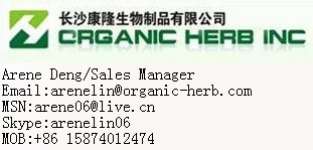Welcome to
Changsha Organic Herb Inc.
Free Member
- Home
- Company Info
- Contact Us
- Trade Offers [1]
- Selling Offers [1]
- Products Catalog [45]
- Giant Knotweed Extract Resveratrol, Email:arenelin@organic-herb.com
- Macleaya cordata Extract, Email:arenelin@organic-herb.com
- Bilberry Extract, Contact Arene with Email:arenelin@organic-herb.com
- Astragalus Extract, Contact Arene with Email:arenelin@organic-herb.com
- Artichoke Extract Powder, Email:arenelin@organic-herb.com
- Angelica Extract.Contact Arene with Email:arenelin@organic-herb.com
- Andrographis Paniculate Extract, Email:arenelin@organic-herb.com
- Aloe Vera Extract, Contact Email:arenelin@organic-herb.com
- Alfalfa Extract, Contact Arene with Email:arenelin@organic-herb.com
- Agaricus blazei Murill, Contact Arene with Email:arenelin@organic-herb.com
- Vinpocetine-Periwinkle plant Extract Vinca Minor L, MSN:arene06@live.cn
- Uva Ursi Extract, Ursolic Acid, MSN:arene06@live.cn
- Tongkat Ali Extract, MSN:arene06@live.cn
- Pumpkin Seed Oil Powder, MSN:arene06@live.cn
- Pansy Extract/Viola tricolor extract, MSN:arene06@live.cn
- Limonin 20~99% HPLC, MSN:arene06@live.cn
- Kola Nut Extract , MSN:arene06@live.cn
- Irvingia gabonensis Seed extract, MSN:arene06@live.cn
- Huperzine A 1% 5% 98%, MSN:arene06@live.cn
- Ginkgo Biloba Extract, MSN:arene06@live.cn
- Germinated Brown Rice GABA Gamma-Aminobutyric Acid, MSN:arene06@live.cn
- Echinacea Extract, MSN:arerne06@live.cn
- Cordyceps sinensis Extract, MSN:arene06@live.cn
- Citrus Aurantinum Extract, MSN:arene06@live.cn
- Cinnamon Bark Water Extract, MSN:arene06@live.cn
- Cat's Claw Extract, MSN:arene06@live.cn
- Cassia nomame Extract, MSN:arene06@live.cn
- Burdock Root/Seed Extract, MSN:arene06@live.cn
- Bupleurum Falcatum Extract, MSN:arene06@live.cn
- Black Sesame Seed Extract / Sesamin-Sesame Seed Lignan, MSN:arene06@live.cn
- Black Cohosh Extract Powder, MSN:arene06@live.cn
- Astaxanthin - Microalga Haematococcus Pluvialis Extract, MSN:arene06@live.cn
- Alpha Lipoic Acid, MSN:arene06@live.cn
- Standardized herbal extracts--MSN:arene06@live.cn
- Oliver Leaf Extract--MSN:arene06@live.cn
- Stevia Leaf Extract--MSN:arene06@live.cn
- Yohimbine HCL --MSN:arene06@live.cn
- Resveratrol-Grape Skin Extract capsules--MSN:arene06@live.cn
- Green Tea Extract polyphenol catechins EGCG 99%--MSN:arene06@live.cn
- Ginkgo Biloba Extract-MSN:arene06@live.cn
- Kola Nut Extract--MSN:arene06@live.cn
- Black Tea Extract 40%theaflavin--MSN:arene06@live.cn
- Taurine 10% 98%--MSN:arene06@live.cn
- Huperzine A 1% 5% 98%--MSN:arene06@live.cn
- Rhodiola Rosea Extract--MSN:arene06@live.cn
- Share your thoughts
- Language
showing 33 of 46


